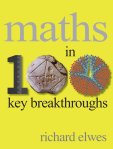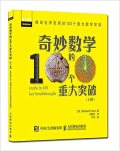This page contains reviews and errata for my book Maths in 100 Breakthroughs, Quercus, August 2013. You can read an extract online here, and buy the book from the usual places.
If you know of anything which should be here but isn’t, I would be immensely grateful if you could email me at r [DOT] elwes [AT] gmail [DOT] com or leave a comment here.
Reviews
“I do… like Elwes’ effort to combine math text and gorgeous graphics in a delicious way, that flows along nicely… I always find Elwes to be one of the very best, clearest, current explicators of mathematical ideas for a lay audience… a splendid introduction to the variety and range of mathematics, especially for a young person with such inclinations… I highly recommend this beautiful book, especially if you… fancy the concept of combining wide-ranging, informative mathematical text with beautiful illustrations.”
“an inspirational panorama of mathematics… For a book aimed at the general reader this book has an impressive and ambitious range… Elwes’ judgement here is exquisite, showing a sensitive understanding of the right balance. I found the book quite hypnotic, moving from one breakthrough to another, and enjoyed the multitude of imaginative illustrations… There are lovely sections on Ramsey Theory, the Continuum Hypothesis, Polytopes, Non-standard Analysis,….; and Elwes conveys the ideas effectively and without fuss… I can imagine a school pupil being set on the path to reading further on topics of choice, and such a book can only enhance the popularity of this exciting subject. “
“Elwes has a clear and un-embellished voice and a very focused, entertaining way of relating the facts as regards concepts which, to say the least, can be highly intimidating… Elwes is superlative at making it accessible for the lay reader…. In this ability, Elwes is comparable to Carl Sagan, the premiere populist science writer of the last century – although he stops short of Sagan’s penchant for grandiosity. I appreciate the author’s attention to detail… This one’s a keeper”
“Bought this book today; 3 chapters in and really enjoying it. As a teacher and mathematics graduate, I am very appreciative of the interesting and wide-ranging topics covered (my thesis was actually on the geometry of quasicrystals!) which I could not study at uni. Thanks!”
“Richard Elwes’ book is my new favorite … of 2014… If I had a book like this when I was a teenager, it would have been my favorite of all time…. The history aspect is fabulous. So far I’ve passed from Greek mathematicians to the Muslim researchers of the Middle Ages, and now to 17th century Europe in the first quarter of the book… I finished breakthroughs 21 through 24 last night and went to sleep amazed at a thought I never had considered before.”
“This is an exciting, mind-expanding and accessible introduction to 100 [ground-breaking] discoveries in mathematics…. Anyone who considers mathematics to be an unapproachable subject should be pleasantly surprised by Richard Elwes’s engrossing, illuminating and beautifully illustrated book.”
“the book is a delight, giving me new perspective on aspects of mathematics I did, but didn’t really understand or appreciate sixty years ago”
“Wow. Bought this for my brother… and he is in love”
“I LOVE THIS BOOK!!”
“fab book!”
“Fantastic!… The artwork is also top notch. It’s visually pleasing and intellectually stimulating. I love this book.”
“As he explains discoveries that have changed the math world and understanding of the universe, along with their history, Dr. Elwes inspires all readers to take an interest in the math surrounding them… A must-read for all those interested in learning the most important concepts of math”
“A fascinating read!”
Errata
P.47 Line -10 & -9 “…exactly half that…”
[10/2013 – Thanks Chris H]
P.81 Caption: the Vostok research station is in Antarctica, not Northern Russia.
[2/2014 – Thanks George Peterson]
P.95 The displayed Fibonacci sequence should end “34, 55,….”
[10/2015 – Thanks Elliot Stevens]
P.98 Caption “…a value around 0.577.”
[12/2013 – Thanks Roman Groblicki]
P.162 Line -4 “( P(A|B) times P(B) = P(B|A) times P(A) )”
[10/2013 – Thanks Chris H]
P.171 Line -12 “delayed” should read “advanced”
[10/2013 – Thanks Chris H]
P.178 Lines 21–22 “2 is the cube root of 8”
[2/2014 – Thanks David C]
P.275 Line 12 “six” should read “five”.
[9/2013 – Thanks to Mr R.]
P.321 Caption the words “lower half” and “upper half” should be swapped.
[2/2014 – Thanks David C]
P.386, last line: Delete “are a”
[2/2014 – Thanks David C]
P.397 “Discoverer”, A Clarification (11/12/2017)
I have been asked to say some words about the beginnings of the field of Reverse Mathematics. My understanding – as I described on P.284 of my book Maths 1001 – is that the field was founded by Harvey Friedman, to my knowledge, essentially single-handedly.
Now, I do not insist that this claim is correct. I am not an expert in either Reverse Mathematics or its history, and anyone with more knowledge than me is welcome to take issue with that view. I do not wish (and am not qualified) either to participate in or to referee a dispute on this topic! However, what I do insist upon is that the previous paragraph represents my current, honest understanding of the matter.
Confusion arises because a page from another of my books (Mathematics in 100 Key Breakthroughs, P397), is currently being used as evidence to argue otherwise: http://www.personal.psu.edu/t20/Elwes.pdf
The key point, and I fully accept that this appears contradictory, is that there is a box on that page marked “Discoverer”, which contains 3 names, of which Friedman is only one. How can this be reconciled with my stated view above?
Here is my answer. Each of the 100 chapters in that book has a “Discoverer” box on the first page, and when writing the book, I found it very difficult to know who to include or omit. Who “discovered” combinatorics? Who “discovered” tessellations? “Discoverer” is undoubtedly imperfect terminology, but that was an editorial decision out of my hands. I chose to interpret it rather more broadly as “people who made significant relevant discoveries”, rather than (necessarily) people who made the initial breakthrough/ founded the field/ etc..
Thus I decided to list Gerhard Gentzen who in 1936 essentially opened the door to the possibility of asking and answering any questions at all in this area, Harvey Friedman who as I understand it founded the field of Reverse Mathematics in the 1970s, and Steven Simpson who subsequently made discoveries within the field, notably in his 1999 book Subsystems of Second Order Arithmetic.
This is surely an incomplete picture, and possibly an erroneous one. But I can say that it does at least represent my honest understanding of the situation.




Pingback: Richard Elwes – Constructible Numbers